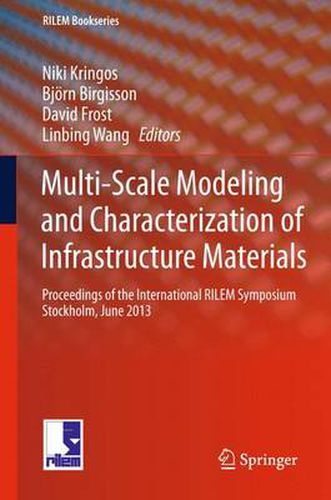Readings Newsletter
Become a Readings Member to make your shopping experience even easier.
Sign in or sign up for free!
You’re not far away from qualifying for FREE standard shipping within Australia
You’ve qualified for FREE standard shipping within Australia
The cart is loading…






This title is printed to order. This book may have been self-published. If so, we cannot guarantee the quality of the content. In the main most books will have gone through the editing process however some may not. We therefore suggest that you be aware of this before ordering this book. If in doubt check either the author or publisher’s details as we are unable to accept any returns unless they are faulty. Please contact us if you have any questions.
The micro- and nano-modification of infrastructure materials and the associated multi-scale characterization and simulation has the potential to open up whole new uses and classes of materials, with wide-ranging implications for society. The use of multi-scale characterization and simulation brings the ability to target changes at the very small scale that predictably effect the bulk behavior of the material and thus allowing for the optimization of material behavior and performance.
The International RILEM Symposium on Multi-Scale Modeling and Characterization of Infrastructure Materials (Stockholm, June 10-12, 2013) brought together key researchers from around the world to present their findings and ongoing research in this field in a focused environment with extended discussion times. From asphalt to concrete, from chemistry to mechanics, from nano- to macro-scale: the collection of topics covered by the Symposium represents the width and depth of the currently ongoing efforts of developing more sustainable infrastructure materials.
Researchers, practitioners, undergraduates and graduate students engaged in infrastructure materials or multi-scale characterization and modeling efforts can use this book as a comprehensive reference, to learn about the currently ongoing research efforts in this field or as an inspiration for new research ideas to enhance the long-term performance of infrastructure materials from a fundamental perspective.
The Symposium was held under the auspices of the RILEM Technical Committee on Nanotechnology-Based Bituminous Materials 231-NBM and the Transport Research Board (TRB) Technical Committee on Characteristics of Asphalt Materials AFK20.
$9.00 standard shipping within Australia
FREE standard shipping within Australia for orders over $100.00
Express & International shipping calculated at checkout
This title is printed to order. This book may have been self-published. If so, we cannot guarantee the quality of the content. In the main most books will have gone through the editing process however some may not. We therefore suggest that you be aware of this before ordering this book. If in doubt check either the author or publisher’s details as we are unable to accept any returns unless they are faulty. Please contact us if you have any questions.
The micro- and nano-modification of infrastructure materials and the associated multi-scale characterization and simulation has the potential to open up whole new uses and classes of materials, with wide-ranging implications for society. The use of multi-scale characterization and simulation brings the ability to target changes at the very small scale that predictably effect the bulk behavior of the material and thus allowing for the optimization of material behavior and performance.
The International RILEM Symposium on Multi-Scale Modeling and Characterization of Infrastructure Materials (Stockholm, June 10-12, 2013) brought together key researchers from around the world to present their findings and ongoing research in this field in a focused environment with extended discussion times. From asphalt to concrete, from chemistry to mechanics, from nano- to macro-scale: the collection of topics covered by the Symposium represents the width and depth of the currently ongoing efforts of developing more sustainable infrastructure materials.
Researchers, practitioners, undergraduates and graduate students engaged in infrastructure materials or multi-scale characterization and modeling efforts can use this book as a comprehensive reference, to learn about the currently ongoing research efforts in this field or as an inspiration for new research ideas to enhance the long-term performance of infrastructure materials from a fundamental perspective.
The Symposium was held under the auspices of the RILEM Technical Committee on Nanotechnology-Based Bituminous Materials 231-NBM and the Transport Research Board (TRB) Technical Committee on Characteristics of Asphalt Materials AFK20.